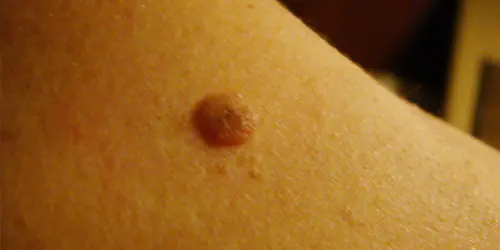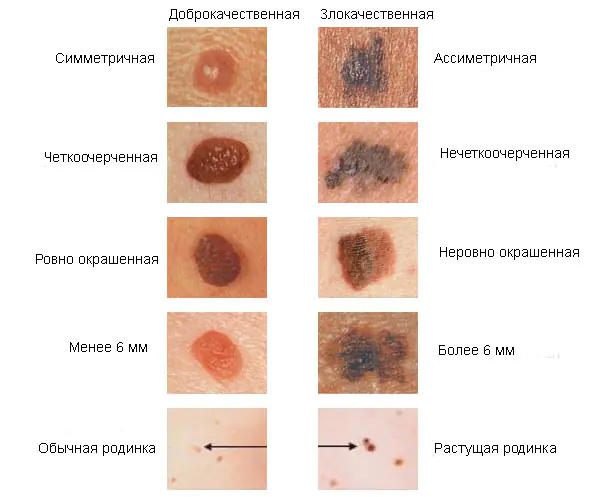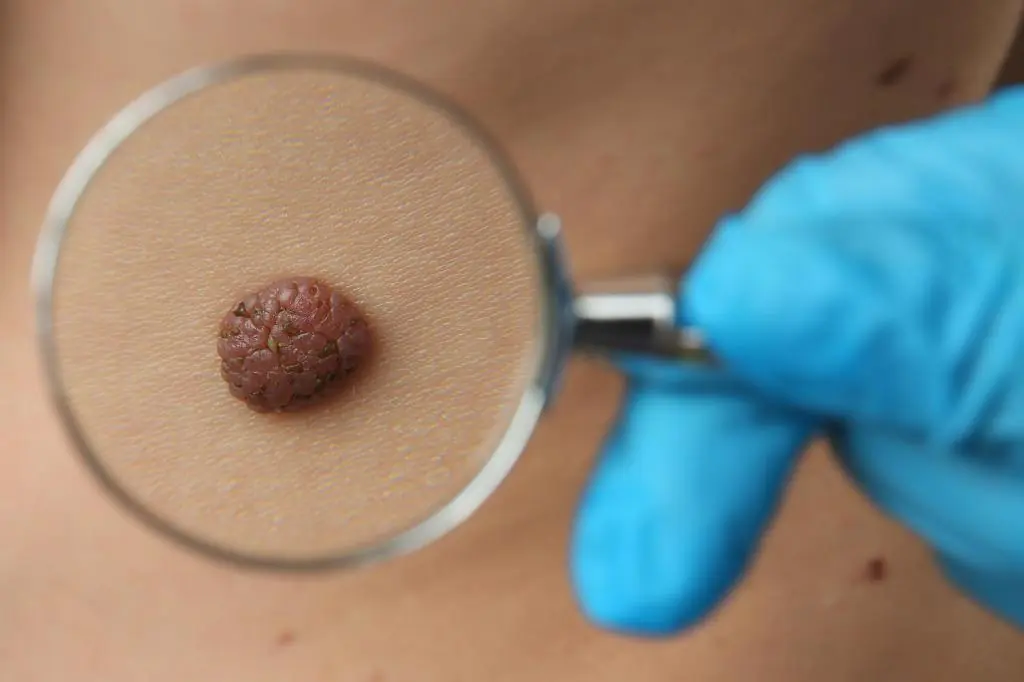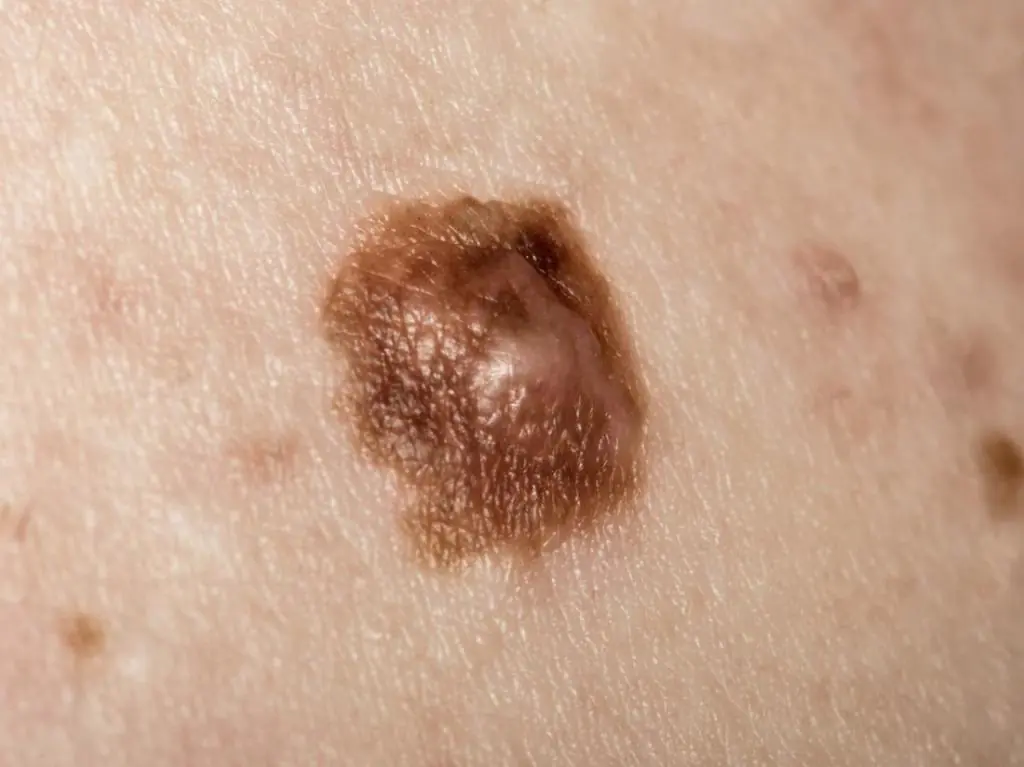A mole is a pigmented neoplasm that can be on any part of the body.. Often in medical practice, nevus appears on the mucous membranes of the body. The color of the spots can be brown, black, red, purple. Neoplasms are considered benign and very often do not bother a person throughout his life. But sometimes they begin to cause discomfort, and a person is faced with the question: why does a mole hurt and what to do?

Causes
The appearance of moles on the body often does not cause panic. But at some point she starts to get sick. The main cause of the appearance of nevi are viruses, so if you experience discomfort or changes in the shape of a mole, you should contact a specialist.
Why does a mole hurt? The answer to this question will be received after the necessary measures have been taken. But very often the cause is their injury.. In men, the appearance of painful sensations on the face may indicate improper handling of the razor. A mole on the back, located in the area where the bra is located, very often becomes inflamed due to constant friction with underwear.
Very often, voluminous neoplasms appear in areas more open to damage. For example, on the face, hands, neck, scalp.
For what other reasons does a mole hurt? This may be repeated injury to the tumor with infection in the wound. Or the patient’s predisposition to cancer. Soreness appears when a person spends a long time in the sun or in baths, or with intensive growth of a mole.
What to do if a mole starts to hurt?
If a mole hurts when pressed or touched, or itches constantly, you should not put off visiting a doctor, otherwise this may lead to its malignancy.
If a large tumor is partially torn off, you must take precautions yourself and then contact a specialist:
- First, the wound must be treated with hydrogen peroxide and a sterile bandage applied to the damaged area.
- Secondly, in order to test the torn part for the presence of cancer cells, it must be placed in any container and filled with saline solution.
- Thirdly, go to an appointment with an oncologist or dermatologist.
In this case, most often the treatment is aimed at completely removing the remnants of the nevus, relieving pain and preventing inflammatory processes.
If a mole on your face hurts, when you contact a specialist, you will be examined and further treatment measures will be outlined. But most often, a specialist will advise removing it completely to prevent injury and re-infection. In this case, the patient will be offered several options for performing the operation:

- removal with a scalpel;
- exposure to a mole using a laser or current.
If, after damage to the mole, an inflammatory process begins, the doctor will prescribe a course of antibiotics, local anesthesia, and the application of compresses to prevent the germs from reentering.
For no apparent reason
What to do if a mole hurts for no reason? Most often, redness and growth of a nevus indicate the growth of cancer cells. The impetus for this can be going to saunas or solariums. If you see a doctor immediately, you need to get tested. And if it is confirmed that the mole has grown into a malignant one, a course of chemotherapy will be prescribed. Treatment will be aimed at stopping the process or inhibiting cell growth.
Drug or surgery does not guarantee complete removal of cells. Very often they are located deep under the skin, and during surgery only the superficial part of the tumor is removed.
Therefore, for treatment it is necessary to prescribe procedures aimed at determining the depth of the cells. This greatly simplifies the treatment process.
Prevention of the appearance or overgrowth of a mole is to regularly visit doctors to monitor the process of cell growth, changes in size or color.
If your body is covered with multiple nevi, you should avoid artificial tanning and reduce your time in the sun. If voluminous moles are located on open areas of the body, it is best to remove them without waiting for injury.
Removing moles by any surgical method is a painless procedure, after which the location of the mole heals within a few days. It is best to remove nevi in clinics under the constant supervision of the attending physician. You should refuse the services of beauty salons: the risk of infection of neoplasms is high.
If any changes in the mole, itching or pain appear, you need to seek the help of qualified specialists. It is better to refuse treatment with folk remedies: this does not always lead to the desired result.
Every person can have a nevus on their body, and more than one. As a rule, it does not cause any discomfort or concern. But there are cases when the mole hurts when pressed. There is no point in delaying here. Before we find out the reasons for the appearance of a painful condition, let’s consider what they are.
Types of moles
There are two types: congenital and acquired. The former are usually inherited. They vary in size, shape and color.
The emergence of the latter is facilitated by a large number of reasons:
- there is a change in the radioactive background;
- receiving a large dose of ultraviolet radiation;
- puberty, pregnancy, some diseases - in a word, changes in hormonal levels;
- genetics.
Moles are divided into non-vascular and hemangiomas.
The first ones are flat, convex, and of various shapes. Color - from flesh to black. May appear as a dot or a large spot.
Hemangiomas appear when blood vessels are damaged. They are pink or red in color. In turn, they are divided into:

- capillary (located on the surface);
- cavernous (located on the skin).
There are also times when moles form on their own. This phenomenon is not dangerous to human health.
Why does a mole hurt?
Pain receptors are located on the surface of the skin. In addition, any nerve endings that are irritated cause unpleasant pain. The nevus is located in the skin, which means it reacts to irritation in the same way as the skin.
High and low temperatures, injuries, and burns can provoke the appearance of unpleasant sensations. In this case, the mole begins to hurt when pressed, but not only it. Painful sensations occur on the skin nearby. And that's not so bad. It’s worse if only the location of the nevus hurts.
The mole begins to hurt, because when the epithelial cover is destroyed, the nerve endings are exposed.
If pain appears at the site of the spot, you should look for the cause of its formation. Only a specialist (dermatologist) will be able to correctly determine what caused this condition.
Now let's take a closer look at the main factors that provoke the appearance of painful sensations.
Injury
This is one of the reasons why a mole on the back hurts when pressed, and not only on the back. Often these spots are located in inconvenient places. They can be damaged by straps, belts, belts and just clothing. Nevi located on the neck are injured when using a washcloth during water procedures.
Flat warts, which look completely harmless, can be damaged during depilation or shaving.

Hanging growths are most often damaged by clothing. Constant irritation contributes to the destruction of the top layer. Nerve endings become exposed and react painfully to every touch. This mole begins to hurt when pressed.
Hanging growths are often rubbed by clothing. Due to constant trauma, the top layer is erased, the nerves of the tubercle become exposed. Frequently rubbing a mole can cause cell degeneration. A benign growth degenerates into a malignant one. A mole starts to hurt, what should you do in this case?
First you need to determine the extent of the damage. If the nevus is completely torn off, treat the wound and apply an antiseptic bandage. Go to the doctor immediately. The specialist will conduct an examination and, if necessary, prescribe treatment.
Ultraviolet
The reason why a mole on the face hurts when pressed is often sunburn. Pigmented formations are often found on the face. Ultraviolet rays affect them differently than normal skin. Their contact with cells provokes the appearance of a malignant formation.
There are nevi, which when they appear on the skin are already predisposed to degeneration. The impetus for this process is ultraviolet light. The mole begins to itch and hurt. Those spots that are located on the face or neck especially make themselves felt. They are constantly exposed to sunlight. That is why it is advisable to avoid direct sunlight, and parts of the body where the nevus is located should be covered with clothing.
If a mole begins to hurt when pressed after prolonged sunbathing, try to prevent it from becoming infected. Treat this area of the body with an antiseptic, apply a sterile bandage to the stain and be sure to consult a specialist.
Inflammation
The homeland hurts when pressed - the cause may be inflammatory processes. Untreated damaged tubercles provoke their appearance. Usually, a nevus can be accidentally caught and simply not noticed. Microbes get inside the wound and begin their “dark” business. The skin around the mole turns red, swells and hurts. A kind of deping rim appears. It prevents diseased cells that are trying to actively reproduce from spreading. In this case, you cannot do without a specialist. As a last resort, see a dermatologist, but it is best to see a dermatologist. It determines the nature of education.

You can try to get rid of the problem at home. But these measures are carried out at the initial stage of the inflammatory process. And even if you managed to relieve inflammation, consulting a specialist would not hurt. Only he will be able to determine the nature of the inflammatory process and prescribe appropriate treatment.
Rebirth
All the reasons that were listed above answer the question of why a mole hurts when pressed. If you do not pay attention to the problem, the nevus will begin to degenerate. Benign formations that are constantly exposed to injury can provoke changes in cells. Inflammatory processes occurring in moles indicate the initial stage of degeneration. Without expert supervision, a small bulge can become a big problem.
The first stage of change is characterized by the following symptoms:
You should immediately consult a doctor. A change in pigmentation indicates that the nevus is turning into melanoma. Timely treatment can prevent cancer cells from developing.
If a mole becomes inflamed in an elderly person, consultation with an oncologist is necessary. With age, the body weakens, and the development of pathological processes intensifies.
What to do if a mole becomes inflamed
The mole hurts when pressed, what should I do? The most important step is to stop self-medicating and panicking. Redness does not always indicate that rebirth is occurring. To this symptom many others must be added.

Now recommendations on what to do:
- Soak a gauze pad: one part chlorhexedine, the same amount of dimexidine and two parts water.
- Apply the compress to the inflamed area for half an hour. The procedure is carried out three times a day. Treatment lasts five days.
Most often, soreness and redness disappear during this time. If the remedy does not help, go to a specialist.
You can also try using ointments with zinc and salicylic acid. They should help reduce the inflammatory process of antibiotics.
To prevent re-damage, apply a patch to the nevus.
You will need to urgently visit an oncologist if the mole:
- changed in size;
- turned black or red;
- does not become “normal” within a week.
On the back
If a mole on your back hurts, most likely it was accidentally damaged. In any case, you should consult a doctor. After the examination, the doctor will recommend tests. This procedure is necessary to detect melanoma at an early stage. Only after this the nevus is removed. There are several ways to help get rid of the growth. The most common is laser removal. You can also remove a mole using electric current or freezing.
If necessary, chemotherapy is performed, but only on the recommendation of a doctor. This procedure is used to stop the growth of “harmful” cells or at least slow it down.
As noted above, you should not hesitate if the nevus turns red, begins to hurt badly, or changes its size and shape. This is the first sign that something not very good is happening. In this case, there is no self-medication, only a specialist examination will help you find the right way out of the situation.
On the face and neck
Unpleasant cosmetic effects are caused by spots on the face. Such nevi are rushed to be removed, even without the appearance of pain and their degeneration.
If a mole on your face hurts when pressed, it is urgently necessary to be examined. A highly qualified specialist, after an external examination of the stain, can immediately tell what measures should be taken. One option is deletion.
If a growth on the neck is damaged, there may be a risk of it degenerating into melanoma. Most often, a small “pimple” is invisible, but it is easy to damage. You can touch a nevus when combing or changing clothes. Especially if it is under the hair or where the skin touches the stitches.
If the growth begins to hurt, it is most likely damaged. Even the smallest injury can trigger the development of bad cells (skin cancer). Don't expect the pain to go away on its own. Contact your doctor immediately. Only he can stop the degeneration of the spot and save him from serious consequences.
Health care
What can a specialist advise if you contact him? If the pain appeared after the nevus was damaged or it came off, then most likely you will be advised to remove it.

If a wound has formed at the site of the bulge, a bandage with an antiseptic solution (for example, hydrogen peroxide) will help. If a mole comes off at home, put it in saline solution, close the jar tightly and give it to the doctor. A specialist will conduct a study. Only after this will treatment be prescribed.
The doctor may recommend removing the nevus if it is located in a traumatic area. Remember, this procedure should be carried out in a specialized institution, and not in a beauty salon.
The painful condition appears when touched. In this case, the doctor will conduct an examination using a dermoscope. The mole will be more clearly visible.
If, in addition to pain, itching appears, the specialist prescribes medications for it. Nevus cannot be scratched.
In any case, if a mole hurts, you should consult a doctor. Skin cancer in its early stages responds well to treatment.

Prevention and safety rules
To prevent an ordinary mole from becoming a big problem, preventive measures must be taken.
- Don't stay in the sun for too long.
- Give up bad habits.
- All diseases must be treated on time.
- If itching, pain, or cracking occurs, immediately visit a medical facility.
- If a mole hurts, then do not ignore it.
Now we’ll tell you a little about safety measures if a mole on your head hurts when you press it.
In order not to injure the growth:
- Do not use care products if they are aggressive (peelings, scrubs).
- Try not to influence it mechanically.
- Observe the shape and size of the mole.
- Never remove the growth yourself.
If a mole hurts, what should you do? Contact your doctor immediately, especially if the following symptoms appear:
- The shape of the growth has changed and it is growing.
- The mole hurts, the area nearby has become sensitive.
- The spot peels off, a burning sensation is felt, and slight bleeding appears.

Conclusion
Take care of your health. Remember that even a small mole can become a big problem. Only a specialist will make the correct diagnosis and help you find a solution. If painful sensations appear, immediately go to a highly qualified specialist.
Throughout his life, a person develops moles. They can be located on the head, back, chest, stomach. Benign neoplasms are not noticed until they cause discomfort and anxiety. But if a mole swells or hurts when touched, this is a signal to consult a doctor.
Why does a mole hurt?
Some birthmarks serve as a source of development of unpleasant painful processes. The reason for concern is the change in their size and color. There are several factors why pain occurs:
- mechanical damage;
- temperature changes in the body;
- external stimuli.
A convex neoplasm, similar to a pimple, is often touched with a hand or scratched with a razor or epilator. It can be injured by touching it with clothing or a hard washcloth. Sometimes a mole on the back or shoulder blade hurts. This happens in women when they rub with their bra.
There are birthmarks that tend to develop into a malignant tumor. They must be hidden from the sun's rays. Ultraviolet light accelerates the activation process. Therefore, it is recommended not to expose nevi to external irritants.
What to do if a mole hurts without injury
An alarming signal is the pain of the tumor without causing injury. Aching discomfort can be caused by many factors. Pain can be of different types. You cannot do without medical help here.
If a mole hurts when pressed
The reason for contacting a doctor is if a mole hurts when pressed lightly. After examining the tumor and studying the medical history, the specialist determines treatment. This can be removed by any of the modern methods. Having studied the obtained tests, the specialist prescribes the following types of surgery:
- laser destruction;
- cryodestruction;
- electrocoagulation;
- deep freezing with liquid nitrogen;
- hardware method using a radio knife.
Reviews testify in favor of laser removal. Its advantage is the efficiency and speed of the procedure, as well as the fact that the operation can remove large moles. After surgery, you need to take care of the damaged area.
A growth that pulsates is dangerous. If it is accidentally pricked or touched, it begins to bleed heavily.
If cancer is suspected or if the birthmark is flat, surgery is prescribed.
If a mole hurts after it is damaged
Many patients wonder why a mole hurts or itches. Sometimes it can be partially damaged by tearing off only a part or scratched during hygiene procedures. This often happens if the hanging tumor is located in the armpit or on the leg. Epilation in these areas can cause injury. When cutting, the growths located on the ear and neck are affected. Men can cut with a razor if they are on the cheek. In such cases, it is recommended to carry out a number of manipulations:
- take hydrogen peroxide and treat the affected area;
- cover it with sterile material;
- if there is a lot of bleeding, apply a cotton swab with chlorhexidine and hold until the bleeding stops;
- secure the cotton wool with a bandage;
- if the mole comes off, transfer it to a bowl with saline solution;
- send the material for histological examination.
It is recommended to apply ointments containing an antibiotic to the wounded area. At first it will hurt a little and may turn red. After a few weeks, this reaction gradually goes away.
If an injured tumor begins to bother you, you should consult a doctor. He will conduct an examination and tell you what to do if a mole hurts. Surgery is not always prescribed. Sometimes it is enough to treat the wound with a disinfectant.
If you are experiencing severe pain, you can take painkillers.
If the area hurts after mole removal
It happens that patients have pain in the area of the skin after surgery. This problem is related to the operation itself. Mild pain and itching may be felt for some time, and sometimes peeling occurs. This occurs after contact with a laser or cryodestruction.
There are cases when the area hurts for two weeks after removal of a mole. The tumor swells and begins to bother you. This means that the inflammatory process has begun. In this case, you should re-visit the doctor who performed the operation. Perhaps a professional mistake was made. The doctor could have made a mistake in determining the depth of the birthmark, so there was an impact on healthy tissue.
After prolonged exposure to the sun
The sun has an adverse effect on tumors. Uncontrolled exposure to direct rays causes burns on thin pink skin, which burns easily. Therefore, pain occurs.
To avoid harm to open moles on the face and forehead, it is recommended to lubricate them with sunscreen while tanning.
After extraction, it is not recommended to visit solariums and beaches. If neoplasms located in open areas become painful after exposure to the sun, you can use the following recommendations:
- treat with an antiseptic;
- cover with a bandage until complete healing;
- consult your doctor.
The new epidermis will finally form in 3–4 months. All this time you need to make sure that the growths do not get sunstroke.
Who to contact and what to do
After injury or sunburn of a birthmark, acute pain occurs. In this regard, many patients try to visit a dermatologist as quickly as possible. You need to consult a specialist, but this should not be done right away. The first symptoms, such as discoloration and swelling, make it difficult to make a diagnosis. After 2 days a crust will form, which will fall off on its own after 14 days. This means that the wound has healed. It is recommended to contact a doctor when the inflammation decreases.
If suppuration is visible or the damaged growth hurts when pressed lightly, a doctor’s intervention is needed.
Having examined the sore spot and discovered an active inflammatory process, he prescribes complex therapy:
- taking local antibiotics;
- anti-inflammatory compresses;
- painkillers.
If the tumor hurts and swells, it is recommended to visit a dermatologist. After conducting an examination, he can send you to an oncologist. After studying the examination results, appropriate therapy is prescribed.
Before visiting a doctor, you can use the harmless advice of traditional medicine:
- dip a cotton swab into the vinegar solution;
- press it to the disturbing area and leave for 10–15 minutes;
- can be disinfected with brilliant green or hydrogen peroxide.
Try to remove all irritants that touch the wounded birthmark.
What tests should you take if a mole hurts?
To deal with the growth that is bothering you, it is recommended to conduct a special examination. One of the reliable ways to study it is histology. It is prescribed when:
- the tumor begins to grow;
- painful sensations and peeling are felt;
- bleeding;
- changes its color abruptly to a dark color;
- a compaction has appeared;
- the shape changes.
A mole deserves attention from specialists if it appears immediately after the birth of a child.
During pregnancy, neoplasms that appear are explained by changes in hormone levels, so they do not pose a danger.
The examination is carried out in laboratory conditions, where a morphological analysis of the material is carried out. To do this, a scraping is taken, placed in a special solution and sent to the laboratory. Then they are stained and examined under a microscope.
If the examination shows the presence of malignant cells, the patient is prescribed appropriate therapy.
To ensure the accuracy of the diagnosis, medicine offers a number of methods:
- studying the anamnesis, allowing you to find out how long ago the growth began to bother you, whether it changed color, shape, whether it hurts when pressed;
- dermatoscopy, assessing the dynamics of changes in the birthmark;
- confocal laser scanning microscopy;
- radioisotope diagnostics;
- tumor marker analysis;
- inspection of the growth;
- radioactive research;
- layer-by-layer study of structure;
- An accessible and informative diagnostic method is ultrasound.
To prevent cancer from developing, you need to contact a doctor at the first suspicious symptoms.
Moles are harmless new growths. But exposure to ultraviolet radiation, close friction with clothing, and injury can lead to their degeneration into melanoma. If a mole hurts when you touch it, or it increases in size, few people understand what this means. Therefore, in order to avoid negative consequences, seek help from specialists in a timely manner.



